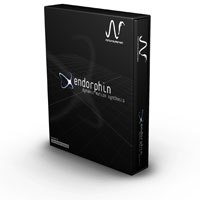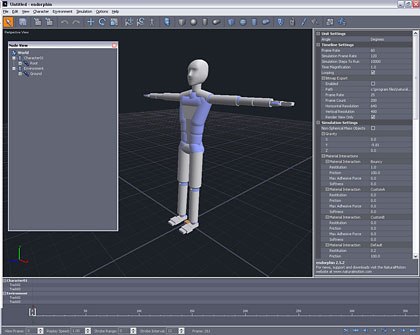Upon the sad news of Wendy Jackson Halls passing, Animation World Network collected the thoughts of the community in tribute to her career in animation.

For many years opinions have flowed on the subject of motion capture as a method for animating virtual characters. Whether they are for use in visual effects or computer game projects, the debate continues. There is the pragmatic, budget-minded camp that sees the savings (in both time and money) in reusing motions for multiple projects. On the other side is the creative perfectionist who requires such subtlety in his characters that the use of motion capture is an affront to his craft. Career animators can usually see both sides of the debate and almost always wind up hoping for an ideal middle ground. While its not the sledgehammer of finality this debate could really use, endorphin 2.5 is a leap forward for both sides.
Created by U.K.-based software developer NaturalMotion, endorphin is the first character animation software to combine dynamics with some fancy artificial intelligence, all in the service of creating believable, often realistic, character animation, practically at the push of a button. Animators need not fear for their jobs, though; the automatic results are nearly always stellar, but theres also plenty of room for animators to have detailed control.
The paradigm endorphin follows is somewhere between an animator and a director. Using existing rigs from any of the industry standard apps, endorphin enables users to try out several solutions to animation problems, without going over budget. Game creators and vfx artists will find endorphin fits smoothly into their pipeline, usually requiring only a handful of extra steps for each character or sequence.
Animators familiar with industry standard apps, such as Maya or 3ds Max, will find themselves at home in endorphin right from the start. The main viewport and the tools for navigating are standard, including the mouse/keyboard combos and the keyboard shortcuts. The timeline also feels familiar, especially if youve used video editing apps such as After Effects. The event-based timeline system allows users to add what are essentially layers of animation to their characters. Forces, such as gravity, are represented in the viewport with three-dimensional icons that make placement and effect obvious and straightforward. Some of the other apps on the market would be wise to learn from the example set by endorphins simple icons. All too often developers create complex iconography when a simple arrow will convey meaning just fine.
Dynamic Motion Synthesis is the term endorphin uses for its slick AI driven character behaviors. Part of the system is a rich behavior set that allows characters to accomplish many simple and complex tasks. For example, users can direct a character to fall backward but extend the fall over an unusually long period so there is some dramatic tension to the sequence. On top of this users can layer additional behaviors. Animators may choose to have the character flail his arms or go completely stiff as he falls. The great thing about endorphin is how flexible it is. With many layers the animation might be expected to breakdown into unusable garbage, but it takes some sincere effort to force endorphin to produce a recognizably poor animation.

In addition to creating believable behaviors for characters, endorphin also allows users to simulate interactions with other characters and also the surrounding environment. Not surprisingly, collisions are fully supported, as are locked limbs. With all of these tools at your disposal its quite easy to set up a scenario where a character leaps from a platform and grabs onto another object in space. Any experienced animator knows animating a trapeze artist flying through the air would take days or even weeks to get right. In one of the examples provided with the software this trapeze sequence is handled easily and beautifully, with only minimal work by the animator. The power of endorphin really shows when the same animator then spends some time conjuring slight variations of the sequence for review by their director.
Motion transfer is endorphin terminology for transferring animation from one rig to another. Amazingly, endorphin manages this feat even between rigs that are quite different from one another. This is mostly achieved by Active Pose Events, more endorphin speak for what are essentially specialized keyframes. While its fair to say these are keyframes, the deeper meaning is that these are keyframes that are overruled by keyframes in the master animation. An example is transferring a walk cycle from an original character rig that doesnt contain a foot roll bone included on the endorphin character rig. When the animation is transferred it plays very well, except for the extra bone, which rotates freely. To fix this, users need only add a keyframe at the beginning of the sequence, to flatten the foot, and then add additional keyframes wherever this free motion is problematic. While this is less than automatic, it is a quick process. The same thinking can be applied to animations that need the little extra human touch to achieve perfect results. Again, endorphin excels because it is so flexible.

The ability to create transitions and use blending within endorphin is another key to the softwares success. The process is so simple, in fact, that blends can be adjusted and previewed in near realtime. This reveals a slight limitation in that any changes need to be simulated before they can be scrutinized by scrubbing or playback. Id like to see NaturalMotion include an option to always simulate. While simulation is taxing on the processor, it doesnt seem to be overly problematic for short, single character cycles. In game animation creation, we often create short loops that would be far easier to tweak if simulation was constantly running. Regardless, simply having the option to blend and then choose an alternate, or a series of alternate blends, is very powerful.
NaturalMotion could have delivered endorphin as complete with the features mentioned so far. Lucky for us theyve taken the software even further. Users can import existing animation from industry standard apps and use endorphins behaviors and collisions to create added nuance. For final rendering or output to a game engine, users can just as easily export the endorphin-enhanced animation back to their original animation package.
The biggest difficulty I faced in my time with endorphin was dealing with the instability of the software. It crashed often, usually without warning or consistency. On the upside, while there were frequent crashes, none took my entire system down and most allowed me to first save the file I was working on. After the first couple crashes, I saved iteratively and lost no more work, a good practice no matter what software you use.
NaturalMotion has created a hugely important tool for professional animators, especially for those with budget constraints. (Isnt that just about everyone?) No longer is motion capture the only option for humanoid character animation. Animators have learned to deal with the near wipeout of traditional hand drawn animation and with great tools such as endorphin becoming available the writing may be on the wall for keyframe animation as well. A quick note to NaturalMotion: please take some time while working feverishly to expand endorphins capabilities to include multiple limb support. As if you havent thought of it already!
endorphin 2.5 is available directly from NaturalMotion via their website. The software is offered in three flavors: Full, Rental and Student. The Full version sells for a hefty $9,495, the monthly Rental goes for $1,195 and the non-commercial Student license is $995.
Fred Galpern is currently the art manager for Blue Fang Games, located just outside Boston. He is also a part-time Maya instructor at Northeastern University and a co-creator of the game development program at Bristol Community College. Since entering the digital art field more than seven years ago, Galpern has held management positions in several game and entertainment companies, including Hasbro and Looking Glass Studios. He began his art career in comic books and also has interactive, print and web graphic design experience.








